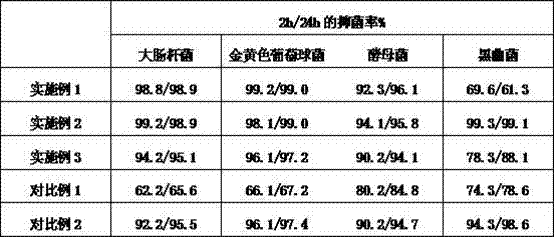Method for preparing chitosan/multilayer hybrid nanoparticle antibacterial preservative film
A technology of hybrid nanoparticle and chitosan, which is applied in the field of food packaging to achieve excellent antibacterial and mechanical properties
- Summary
- Abstract
- Description
- Claims
- Application Information
AI Technical Summary
Problems solved by technology
Method used
Image
Examples
Embodiment 1
[0023] Preparation of organic-inorganic hybrid nanomaterials:
[0024] 1) Disperse 3.0g of nanometer cerium oxide and 1.3g of phosphotungstic acid in 100ml of tetrahydrofuran (the volume ratio of tetrahydrofuran to water is 1:2), and ultrasonically disperse for 30 minutes to obtain a dispersion;
[0025] 2) Heat the dispersion to 55°C, then add phosphoric acid dropwise to adjust the pH to 3.6, then add 2.4g of 2,2'-biimidazole, conduct a hydrothermal reaction at 60°C for 24 hours, then desolvate under reduced pressure at 45°C to obtain a gray-yellow powder , the gray-yellow powder was placed in n-heptane at 50° C. for 2 h, then filtered, aged at 80° C. for 6 h, and pulverized to obtain organic-inorganic hybrid nanomaterials.
[0026] Prepare chitosan / multilayer hybrid nanoparticle antibacterial preservative film, comprising the following steps:
[0027] 1) Preparation of chitosan solution: Disperse chitosan in an aqueous solution of acetic acid, then add polydiallyldimethylam...
Embodiment 2
[0032] The preparation method of the organic-inorganic hybrid nanomaterial is the same as that in Example 1.
[0033] Prepare chitosan / multilayer hybrid nanoparticle antibacterial preservative film, comprising the following steps:
[0034] 1) Preparation of chitosan solution: Disperse chitosan in an aqueous solution of acetic acid, then add polydiallyldimethylammonium chloride, heat and stir to dissolve to obtain chitosan solution;
[0035] 2) Add organic-inorganic hybrid nanomaterials to the chitosan solution, and disperse evenly (the organic-inorganic hybrid nanomaterials can be evenly dispersed at a speed of 200-300rpm, and there is no accumulation of nanoparticle materials after the stirring is stopped. ) after defoaming, then place the dispersion in a glass tank, cast and dry the film-forming precursor;
[0036] 3) Ultrasonicate the membrane precursor at low temperature for 3-5 minutes in a phosphate buffer solution with weakly acidic pH (pH=6.5-6.8), wash the membrane s...
Embodiment 3
[0039] The preparation method of the organic-inorganic hybrid nanomaterial is the same as that in Example 1.
[0040] Prepare chitosan / multilayer hybrid nanoparticle antibacterial preservative film, comprising the following steps:
[0041] 1) Preparation of chitosan solution: Disperse chitosan in an aqueous solution of acetic acid, then add polydiallyldimethylammonium chloride, heat and stir to dissolve to obtain chitosan solution;
[0042] 2) Add organic-inorganic hybrid nanomaterials to the chitosan solution, disperse evenly and defoam, then place the dispersion in a glass tank, cast and dry the film-forming precursor;
[0043] 3) Ultrasonicate the membrane precursor at low temperature for 3-5 minutes in a phosphate buffer solution with weakly acidic pH (pH=6.5-6.8), wash the membrane surface with phosphate buffer salt with purified water, then dry it and demold it to obtain chitosan Sugar / hybrid nanoparticle antibacterial cling film;
[0044] The concentration of chitosan...
PUM
 Login to View More
Login to View More Abstract
Description
Claims
Application Information
 Login to View More
Login to View More - R&D Engineer
- R&D Manager
- IP Professional
- Industry Leading Data Capabilities
- Powerful AI technology
- Patent DNA Extraction
Browse by: Latest US Patents, China's latest patents, Technical Efficacy Thesaurus, Application Domain, Technology Topic, Popular Technical Reports.
© 2024 PatSnap. All rights reserved.Legal|Privacy policy|Modern Slavery Act Transparency Statement|Sitemap|About US| Contact US: help@patsnap.com










